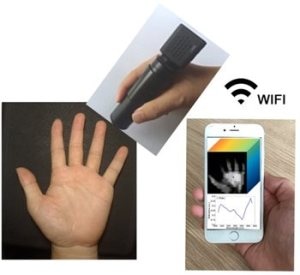Nov 9 2017
Spectral images that have more color information when compared to images obtained from a standard camera divulge properties of tissue and other biological samples that are invisible to the naked eye. An innovative smartphone-compatible device that can be held like a pencil may help in obtaining spectral images of day-to-day objects and may ultimately be applied for point-of-care medical diagnosis in faraway locations.
 A new pencil-like wireless spectrometer can be used with a smartphone to collect 3D spectral images of the body and other objects. This design could make the device useful for point-of-care diagnostics. CREDIT: Dan Wang, Beijing University of Chemical Technology.
A new pencil-like wireless spectrometer can be used with a smartphone to collect 3D spectral images of the body and other objects. This design could make the device useful for point-of-care diagnostics. CREDIT: Dan Wang, Beijing University of Chemical Technology.
Prospective uses of the new device are ascertaining the freshness of meat at the grocery store, detection of oxygen saturation in the blood of an individual, and selecting the fruit with optimum ripeness. The spectrometer can also assist in obtaining spectral data in the field for scientific investigations.
The researchers have described the technique for developing the innovative pencil-like spectrometer in the Biomedical Optics Express journal published by The Optical Society (OSA). They have also validated its potential to obtain spectral images of pork, bananas, and an individual’s hand. The device has the ability to detect wavelengths of 400-676 nm simultaneously at 186 spots.
The easiest way to use a spectrometer is to wave it over the part of the body or object being examined, however, many home-made portable spectrometers use a smartphone camera to acquire data and a phone cradle that contains other necessary optics. The cradle can be hard to align correctly and makes it awkward to wave the smartphone over the body.
Fuhong Cai from Hainan University in China, who is the first author of the study.
Instead of using a smartphone camera for obtaining images, the new device adopts a commercially accessible complementary metal-oxide-semiconductor (CMOS) camera with the ability to wirelessly transmit images to a smartphone. This technique enabled the team to develop a cylindrical spectral imaging device with a weight of merely 140 g, or 5 oz, with the length of a smartphone, and measuring only 3 cm in diameter.
Using off-the-shelf components
The innovative pencil-form spectrometer includes all commercially-accessible components that can be bought for less than 300 US dollars. An array of white LEDs is used as the light source, where the array is connected to an off-the-shelf optical lens tube that includes the CMOS detector and other optical components needed for conducting spectral imaging.
The new device can be simply used by moving it by hand across the target area. This manual push-broom scanning step creates a series of spectral images transmitted to a smartphone or computer where the spectral images are combined together by software to form a 3D spectral image data cube.
The researchers tested the device by using it to detect ripeness of banana and levels of myoglobin in a piece of pork. Myoglobin is the iron-containing protein from which meat gets its color. The team also applied it to scan an individual’s hand and acquired a 16-s video including 200 spectral images. Using the 3D spectral images, the team was able to differentiate the five fingers and the palm and observed differences in the distribution of hemoglobin in different parts of the hand.
The team is also interested in to utilising the compact imaging spectrometer for environmental monitoring.
We’re developing distributed spectral cameras that could be used for a wide range of ocean surveys, such as detecting dissolved organic matter in water or pigments that indicate early signs of harmful algal blooms, since the imaging spectrometer can connect to any type of camera, we are also examining the idea of attaching it to the camera of an autonomous vehicle to create a remote ocean sensing system.
Fuhong Cai from Hainan University in China, who is the first author of the study.
Optimizing the system
Despite the fact that the device can be built by anyone as commercially-accessible components have been used make the prototype, restrictions on sensitivity and resolution do exist. For instance, the prototype has the ability to resolve wavelengths that vary by less than 17 nm.
“We expect significant spectral resolution improvements in the future by using an improved camera with a long focal length lens,” stated Dan Wang from the Beijing University of Chemical Technology, China, who is a member of the team. “These improvements would expand the applications for the device.”
The team is also planning to create software to render the spectral imager more useful.
We want to develop ways to use machine learning algorithms to analyze the massive amounts of data that could be collected with the portable spectra imager, we also want to create software for smartphones that uses spectral imaging data to measure meat freshness, for example.
Sailing He from Zhejiang University in China